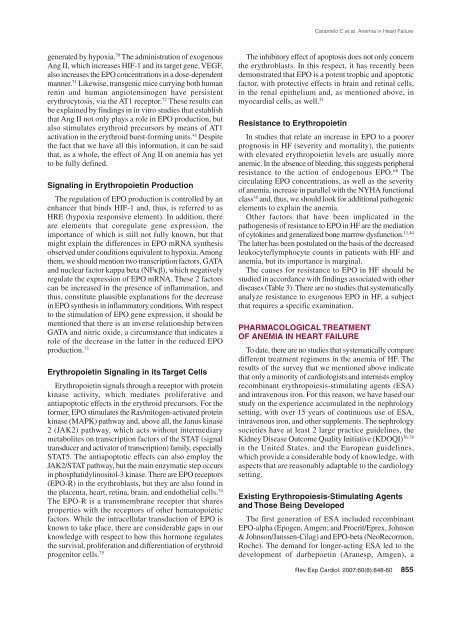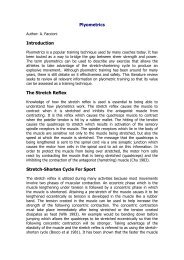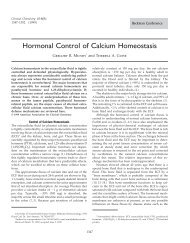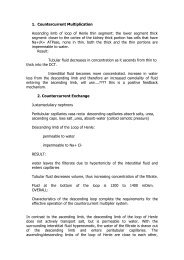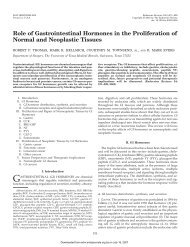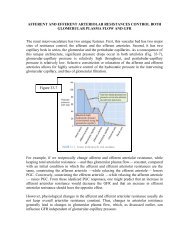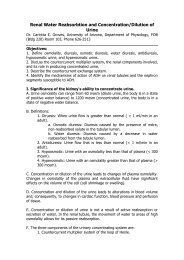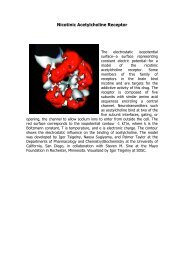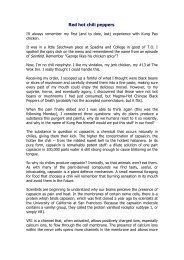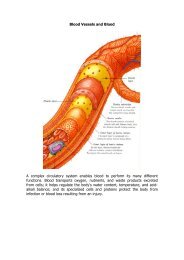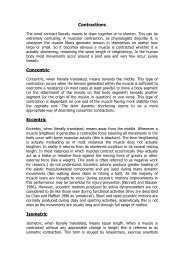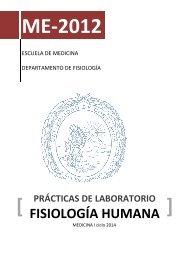Anemia in Heart Failure: Pathophysiology, Pathogenesis, Treatment ...
Anemia in Heart Failure: Pathophysiology, Pathogenesis, Treatment ...
Anemia in Heart Failure: Pathophysiology, Pathogenesis, Treatment ...
You also want an ePaper? Increase the reach of your titles
YUMPU automatically turns print PDFs into web optimized ePapers that Google loves.
Caramelo C et al. <strong>Anemia</strong> <strong>in</strong> <strong>Heart</strong> <strong>Failure</strong>generated by hypoxia. 70 The adm<strong>in</strong>istration of exogenousAng II, which <strong>in</strong>creases HIF-1 and its target gene, VEGF,also <strong>in</strong>creases the EPO concentrations <strong>in</strong> a dose-dependentmanner. 71 Likewise, transgenic mice carry<strong>in</strong>g both humanren<strong>in</strong> and human angiotens<strong>in</strong>ogen have persistenterythrocytosis, via the AT1 receptor. 72 These results canbe expla<strong>in</strong>ed by f<strong>in</strong>d<strong>in</strong>gs <strong>in</strong> <strong>in</strong> vitro studies that establishthat Ang II not only plays a role <strong>in</strong> EPO production, butalso stimulates erythroid precursors by means of AT1activation <strong>in</strong> the erythroid burst-form<strong>in</strong>g units. 41 Despitethe fact that we have all this <strong>in</strong>formation, it can be saidthat, as a whole, the effect of Ang II on anemia has yetto be fully def<strong>in</strong>ed.Signal<strong>in</strong>g <strong>in</strong> Erythropoiet<strong>in</strong> ProductionThe regulation of EPO production is controlled by anenhancer that b<strong>in</strong>ds HIF-1 and, thus, is referred to asHRE (hypoxia responsive element). In addition, thereare elements that coregulate gene expression, theimportance of which is still not fully known, but thatmight expla<strong>in</strong> the differences <strong>in</strong> EPO mRNA synthesisobserved under conditions equivalent to hypoxia. Amongthem, we should mention two transcription factors, GATAand nuclear factor kappa beta (NFκβ), which negativelyregulate the expression of EPO mRNA. These 2 factorscan be <strong>in</strong>creased <strong>in</strong> the presence of <strong>in</strong>flammation, andthus, constitute plausible explanations for the decrease<strong>in</strong> EPO synthesis <strong>in</strong> <strong>in</strong>flammatory conditions. With respectto the stimulation of EPO gene expression, it should bementioned that there is an <strong>in</strong>verse relationship betweenGATA and nitric oxide, a circumstance that <strong>in</strong>dicates arole of the decrease <strong>in</strong> the latter <strong>in</strong> the reduced EPOproduction. 73Erythropoiet<strong>in</strong> Signal<strong>in</strong>g <strong>in</strong> its Target CellsErythropoiet<strong>in</strong> signals through a receptor with prote<strong>in</strong>k<strong>in</strong>ase activity, which mediates proliferative andantiapoptotic effects <strong>in</strong> the erythroid precursors. For theformer, EPO stimulates the Ras/mitogen-activated prote<strong>in</strong>k<strong>in</strong>ase (MAPK) pathway and, above all, the Janus k<strong>in</strong>ase2 (JAK2) pathway, which acts without <strong>in</strong>termediarymetabolites on transcription factors of the STAT (signaltransducer and activator of transcription) family, especiallySTAT5. The antiapoptotic effects can also employ theJAK2/STAT pathway, but the ma<strong>in</strong> enzymatic step occurs<strong>in</strong> phosphatidyl<strong>in</strong>ositol-3 k<strong>in</strong>ase. There are EPO receptors(EPO-R) <strong>in</strong> the erythroblasts, but they are also found <strong>in</strong>the placenta, heart, ret<strong>in</strong>a, bra<strong>in</strong>, and endothelial cells. 74The EPO-R is a transmembrane receptor that sharesproperties with the receptors of other hematopoieticfactors. While the <strong>in</strong>tracellular transduction of EPO isknown to take place, there are considerable gaps <strong>in</strong> ourknowledge with respect to how this hormone regulatesthe survival, proliferation and differentiation of erythroidprogenitor cells. 75The <strong>in</strong>hibitory effect of apoptosis does not only concernthe erythroblasts. In this respect, it has recently beendemonstrated that EPO is a potent trophic and apoptoticfactor, with protective effects <strong>in</strong> bra<strong>in</strong> and ret<strong>in</strong>al cells,<strong>in</strong> the renal epithelium and, as mentioned above, <strong>in</strong>myocardial cells, as well. 51Resistance to Erythropoiet<strong>in</strong>In studies that relate an <strong>in</strong>crease <strong>in</strong> EPO to a poorerprognosis <strong>in</strong> HF (severity and mortality), the patientswith elevated erythropoiet<strong>in</strong> levels are usually moreanemic. In the absence of bleed<strong>in</strong>g, this suggests peripheralresistance to the action of endogenous EPO. 68 Thecirculat<strong>in</strong>g EPO concentrations, as well as the severityof anemia, <strong>in</strong>crease <strong>in</strong> parallel with the NYHA functionalclass 38 and, thus, we should look for additional pathogenicelements to expla<strong>in</strong> the anemia.Other factors that have been implicated <strong>in</strong> thepathogenesis of resistance to EPO <strong>in</strong> HF are the mediationof cytok<strong>in</strong>es and generalized bone marrow dysfunction. 11,44The latter has been postulated on the basis of the decreasedleukocyte/lymphocyte counts <strong>in</strong> patients with HF andanemia, but its importance is marg<strong>in</strong>al.The causes for resistance to EPO <strong>in</strong> HF should bestudied <strong>in</strong> accordance with f<strong>in</strong>d<strong>in</strong>gs associated with otherdiseases (Table 3). There are no studies that systematicallyanalyze resistance to exogenous EPO <strong>in</strong> HF, a subjectthat requires a specific exam<strong>in</strong>ation.PHARMACOLOGICAL TREATMENTOF ANEMIA IN HEART FAILURETo date, there are no studies that systematically comparedifferent treatment regimens <strong>in</strong> the anemia of HF. Theresults of the survey that we mentioned above <strong>in</strong>dicatethat only a m<strong>in</strong>ority of cardiologists and <strong>in</strong>ternists employrecomb<strong>in</strong>ant erythropoiesis-stimulat<strong>in</strong>g agents (ESA)and <strong>in</strong>travenous iron. For this reason, we have based ourstudy on the experience accumulated <strong>in</strong> the nephrologysett<strong>in</strong>g, with over 15 years of cont<strong>in</strong>uous use of ESA,<strong>in</strong>travenous iron, and other supplements. The nephrologysocieties have at least 2 large practice guidel<strong>in</strong>es, theKidney Disease Outcome Quality Initiative (KDOQI) 76-78<strong>in</strong> the United States, and the European guidel<strong>in</strong>es,which provide a considerable body of knowledge, withaspects that are reasonably adaptable to the cardiologysett<strong>in</strong>g.Exist<strong>in</strong>g Erythropoiesis-Stimulat<strong>in</strong>g Agentsand Those Be<strong>in</strong>g DevelopedThe first generation of ESA <strong>in</strong>cluded recomb<strong>in</strong>antEPO-alpha (Epogen, Amgen; and Procrit/Eprex, Johnson& Johnson/Janssen-Cilag) and EPO-beta (NeoRecormon,Roche). The demand for longer-act<strong>in</strong>g ESA led to thedevelopment of darbepoet<strong>in</strong> (Aranesp, Amgen), aRev Esp Cardiol. 2007;60(8):848-60 855


